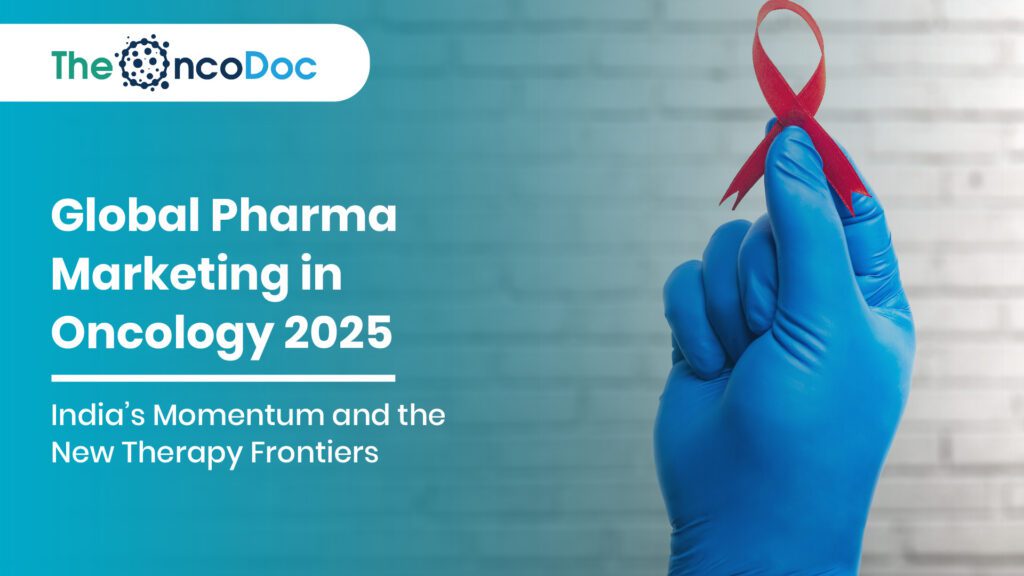Introduction: A Shifting Global Market Landscape
The global pharmaceutical industry is entering an era where oncology remains the dominant frontier of innovation, yet the dynamics are rapidly shifting. No longer confined to developed markets such as the U.S. and Europe, oncology growth is accelerating in emerging economies, with India at the center of this momentum.
India’s oncology market is evolving through a combination of increased research investments, adoption of robotic surgeries, immunotherapies, and government-backed healthcare initiatives. At the same time, the pharma industry is witnessing a strategic expansion beyond oncology and immunology, with significant investments directed toward Alzheimer’s disease, obesity, metabolic disorders, and neurodegenerative conditions.
For pharma marketers, this shift creates both opportunity and complexity: building campaigns that are locally resonant yet globally scalable, patient-first yet technologically advanced, and data-driven yet emotionally empathetic.
This article explores the global market dynamics shaping oncology pharma marketing, India’s unique trajectory, and how therapy focus is shifting to new disease areas, redefining marketing strategies for the future.
1. India’s Growing Oncology Market: A Global Player in the Making
India’s oncology sector is projected to grow at double-digit CAGR through 2030. Several factors drive this growth:
- Rising Cancer Burden: With over 1.5 million new cancer cases annually, India faces an urgent demand for improved screening, diagnosis, and treatments.
- Advancement in Technologies: Robotic surgeries, precision diagnostics, and liquid biopsies are gaining adoption.
- Immunotherapy Uptake: Immune checkpoint inhibitors are becoming more accessible, supported by Indian biosimilar development.
- Government Programs: Ayushman Bharat and state-led cancer care schemes have expanded healthcare accessibility.
- Private Sector Investments: Indian pharma and hospital chains are expanding oncology-specific facilities and R&D.
Pharma marketing in India is uniquely challenged by urban-rural disparities, multilingual populations, and cost-sensitive consumers, requiring hyper-localized campaigns to drive awareness and adoption.
2. The Evolving Role of Pharma Marketing in Oncology
Oncology is unlike any other therapeutic area, decisions are emotional, deeply personal, and time-sensitive. Marketing strategies must therefore extend beyond physician education and incorporate:
- Patient Education in Vernacular Languages to reach Tier-2 and Tier-3 cities.
- Digital Ecosystems offering AI-driven symptom checkers and treatment navigation support.
- Community Engagement Programs to address cultural stigma around cancer.
- Collaboration with Survivor Networks to amplify authenticity and trust.
Pharma brands that succeed in India are not just promoting therapies, they are positioning themselves as health partners across the care continuum.
3. India’s Oncology Market Segmentation
The Indian oncology market demonstrates heterogeneity across cancer types, demographics, and geographies.
Key Patterns:
- Urban India: Higher prevalence of breast, colorectal, and lung cancers due to lifestyle factors.
- Rural India: Higher oral and cervical cancer prevalence, linked to tobacco use and limited screening.
- Younger Populations: Rising incidence of lifestyle-related cancers under age 40.
- Older Populations: More complex, multi-morbidity cancer cases needing specialized care.
Pharma marketers use AI-based segmentation models to design tailored campaigns for these sub-groups.
4. Digital Transformation in Indian Oncology Marketing
India’s oncology marketing landscape is embracing a digital revolution, allowing pharma brands to engage patients and healthcare providers more effectively through omnichannel strategies.
• WhatsApp Health Bots: Automated reminders for screenings, vaccination alerts, and answers to common cancer-related queries.
• Mobile Apps: Tools that support treatment adherence, symptom tracking, and personalized educational content for patients and caregivers.
• Tele-oncology Platforms: Virtual consultations connecting rural and underserved populations with oncology specialists, reducing travel burden and improving timely care.
• Social Media Campaigns: Survivor-led narratives, Q&A sessions, and awareness drives on Instagram, YouTube, and Facebook to humanize messaging and encourage early detection.
By integrating digital touchpoints, pharma companies can make campaigns more interactive, track real-time engagement metrics, and strengthen trust with both patients and physicians. The shift also enables scalable education initiatives while bridging geographic and informational gaps in oncology care.
5. Robotic Surgery and Immunotherapy: New Growth Engines
Robotic surgery is gaining momentum in metro cities such as Mumbai, Delhi, and Bengaluru, particularly for urological and gynecological cancers. The Da Vinci robotic system has become a marketing highlight for premium hospital chains, symbolizing precision and safety.
Meanwhile, immunotherapy adoption, especially PD-1 and PD-L1 inhibitors, is redefining cancer treatment narratives in India. Patient-centered campaigns emphasize:
- Hope and survivorship stories.
- Simplified science communication.
- Cost-access solutions via insurance and biosimilars.
Marketing strategies in this space are aspirational, portraying advanced therapies as a bridge between Indian patients and global standards of care.
6. Global Pharma Expansion Beyond Oncology
While oncology continues to dominate R&D pipelines globally, pharma companies are diversifying:
- Alzheimer’s Disease: With aging populations, investments in disease-modifying therapies (DMTs) and early detection tools are intensifying.
- Obesity: Once overlooked, obesity is now a multi-billion-dollar opportunity, with GLP-1 therapies gaining traction worldwide.
- Rare Diseases & Neurodegenerative Disorders: Increased incentives and orphan drug policies fuel this expansion.
For pharma marketers, this shift requires rethinking narratives: from life-threatening oncology treatments to chronic condition management, requiring behavioral nudges, lifestyle support, and emotional engagement.
7. Lessons from Oncology Marketing for Other Therapy Areas
Oncology has pioneered several marketing innovations that other therapeutic areas are now adopting:
- Survivor Storytelling → Applied to Obesity & Mental Health.
- AI-Powered Early Detection Tools → Extended to Alzheimer’s screening.
- Community-Led Awareness Campaigns → Adopted for metabolic diseases.
Thus, oncology continues to set the gold standard in patient-first, trust-based pharma marketing.
8. The Patient-Centric Imperative in India
Indian patients are more informed than ever, driven by:
- Internet Penetration: Over 800 million users accessing health content.
- Medical Tourism Growth: Global exposure to advanced therapies.
- Rising Middle-Class Expectations: Demanding international standards of care locally.
Pharma companies must balance affordability with aspiration, offering tiered solutions that cater to both urban affluents and rural underprivileged patients.
9. Marketing the India Way: Vernacular + Emotional + Digital
For India’s oncology market, vernacular campaigns in Hindi, Tamil, Bengali, and regional dialects outperform English-led campaigns. Additionally:
- Emotional Storytelling: Survivor voices resonate stronger than technical data.
- Localized Digital Outreach: WhatsApp and community radio dominate rural engagement.
- NGO Partnerships: Extend trust into grassroots communities.
Marketers who design campaigns that blend science with emotion, data with empathy, and technology with accessibility are more likely to succeed.
10. Future Outlook: India’s Role in Global Oncology
India is no longer just a market, it is becoming a global hub for oncology trials, biosimilar manufacturing, and affordable innovation. India provides insights for global pharmaceutical marketing due to its size, diversity, and level of digital maturity:
Cost-sensitive campaigns that still drive innovation.
- Multi-lingual content strategies adaptable to global emerging markets.
- Integration of NGOs, governments, and private players for holistic outreach.
The next decade will likely see India emerge not only as a fast-growing oncology market but also as a blueprint for inclusive, digital-first pharma marketing.
11. The Rise of Value-Based Oncology Marketing
As treatment costs soar, especially with targeted therapies and immunotherapies, value-based healthcare marketing is becoming critical. Patients, insurers, and governments increasingly demand evidence that expensive oncology drugs deliver tangible improvements in survival rates and quality of life.
Pharma marketers are shifting away from promotional campaigns and toward real-world outcome-based narratives. Instead of only highlighting clinical trial data, campaigns now emphasize:
- Cost-to-benefit transparency (explaining why a therapy is priced higher).
- Patient-reported outcomes such as reduced side effects and improved mobility.
- Insurance partnerships that show patients how affordability can be achieved.
This approach transforms oncology marketing into a value communication exercise, where trust is built on transparency rather than persuasion.
12. The Role of AI in Predictive Oncology Marketing
Artificial Intelligence is moving beyond personalization, it is now a predictive force. Pharma marketers use AI not only to analyze past engagement but also to forecast future cancer care needs.
- Predictive Screening Demand: AI can analyze Google searches, hospital intake patterns, and regional health data to identify districts likely to see a cancer surge.
- Dynamic Campaign Adjustment: Campaigns automatically adapt, shifting more resources to lung cancer awareness in polluted urban centers or oral cancer prevention in high tobacco-use regions.
- Clinical Trial Recruitment: AI identifies potential patient cohorts for oncology trials, shortening recruitment timelines.
This makes oncology marketing proactive rather than reactive, positioning pharma brands as early responders in public health.
13. Integrating Preventive Care into Oncology Marketing
Traditionally, oncology marketing has focused on treatment innovations. However, India’s rising cancer burden makes prevention an equally urgent narrative. Pharma brands are now actively integrating preventive oncology into their campaigns.
Key strategies include:
- Tobacco Cessation Campaigns: Partnering with NGOs and schools to reduce oral cancer risk.
- HPV Vaccination Awareness: Targeting parents and adolescents to prevent cervical cancer.
- Lifestyle Education: Using gamified apps to encourage healthier diets, exercise, and regular checkups.
This preventive dimension positions pharma not just as a treatment provider but as a health partner for life.
14. Bridging the Urban-Rural Cancer Care Divide
One of India’s biggest challenges is the urban-rural disparity in cancer care. While metro cities host robotic surgeries, AI diagnostics, and advanced therapies, rural populations still struggle with late detection and limited oncologist access.
Pharma marketing is bridging this gap through:
- Mobile Cancer Screening Vans sponsored by Pharmaceutical companies.
- Telemedicine programs that link oncologists in cities with patients in remote areas.
- Community Worker Training (ASHA & ANMs) with branded oncology toolkits.
- Hyperlocal Campaigns using radio jingles, street plays, and folk art.
By investing in rural campaigns, pharma companies not only expand market penetration but also democratize cancer care access, enhancing their brand reputation.
15. Pharma Marketing in Emerging Therapy Frontiers: Alzheimer’s and Obesity
With pharma pipelines diversifying, Alzheimer’s and obesity are becoming crucial grounds for testing new marketing strategies.
- Alzheimer’s Campaigns: Since caregivers often drive treatment decisions, marketers emphasize awareness and education, focusing on early detection, symptom recognition, and community-based support programs. Campaigns highlight both medical guidance and emotional reassurance.
- Obesity Campaigns: Unlike oncology, obesity is strongly linked with social stigma. Here, marketing balances clinical awareness with lifestyle empowerment, using gamified digital tools, fitness trackers, and motivational storytelling to encourage healthier behaviors.
- Cross-Therapy Learnings: Techniques pioneered in oncology, such as emotional storytelling, digital advocacy, and survivor-driven narratives, are now being applied to Alzheimer’s caregiving journeys and obesity management campaigns.
This evolution reflects how oncology marketing has set the benchmark for pharma’s broader therapeutic strategies, offering models of empathy, personalization, and engagement across new disease frontiers.
16. The Emergence of Patient Advocacy Partnerships
In the evolving oncology marketing ecosystem, patient advocacy groups (PAGs) are becoming powerful allies. These organizations represent patient voices, influence policy, and shape public opinion around new treatments.
Pharma marketers are increasingly collaborating with PAGs to:
- Co-create educational campaigns that address real patient concerns.
- Advocate for faster regulatory approvals of life-saving oncology drugs.
- Support reimbursement negotiations by showcasing the human impact of therapies.
- Amplify survivor stories through trusted community platforms.
This collaboration ensures that campaigns are authentic, empathetic, and socially credible, bridging the gap between corporate goals and patient realities.
17. Sustainability and Green Oncology Marketing
Sustainability is no longer a corporate buzzword, it is an expectation. As the world shifts toward environmentally conscious healthcare, oncology marketing must reflect eco-responsibility.
Pharma companies are adopting:
- Eco-friendly packaging for oncology drugs and diagnostics.
- Digital-first campaigns to reduce print material waste.
- Carbon-neutral awareness events, ensuring healthcare engagement doesn’t come at environmental cost.
- CSR campaigns that link cancer awareness with environmental causes, such as pollution-related lung cancer prevention.
By aligning oncology campaigns with sustainability goals, pharma marketers position their brands as future-ready, responsible, and patient-and-planet-first.
Conclusion
The oncology pharma marketing landscape in 2025 is not just about driving treatment adoption, but about shaping ecosystems of trust, empathy, and inclusivity. India’s growing oncology market demonstrates how digital innovation, affordability, vernacular outreach, and patient-first strategies can create scalable models for the world.
At the same time, global pharma is redefining its focus, expanding into Alzheimer’s, obesity, and rare diseases, while carrying forward the lessons learned from oncology: storytelling, predictive AI, preventive campaigns, rural inclusion, and sustainability.
The future belongs to pharma brands that can combine scientific innovation with human connection, ensuring that every campaign is not just a marketing effort, but a lifeline of awareness, accessibility, and hope.
The Oncodoc team is a group of passionate healthcare and marketing professionals dedicated to delivering accurate, engaging, and impactful content. With expertise across medical research, digital strategy, and clinical communication, the team focuses on empowering healthcare professionals and patients alike. Through evidence-based insights and innovative storytelling, Hidoc aims to bridge the gap between medicine and digital engagement, promoting wellness and informed decision-making.



